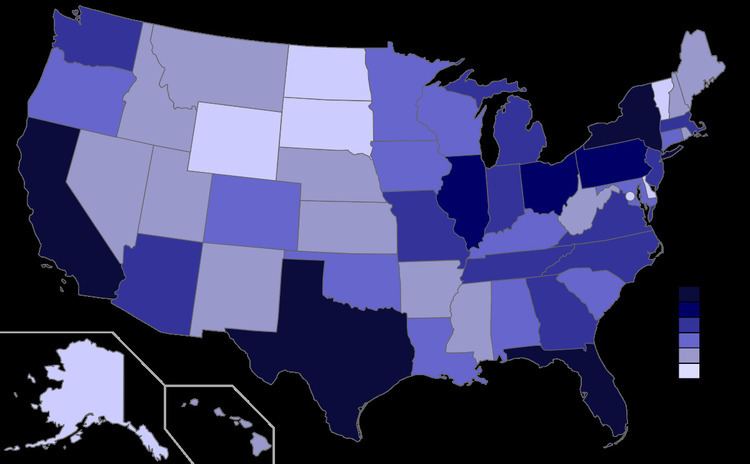 | ||
As of April 1, 2010, the date of the 2010 United States Census, the nine most populous U.S. states contain slightly more than half of the total population. The 25 least populous states contain less than one-sixth of the total population. California, the most populous state, contains more people than the 21 least populous states combined.
Contents
Methodology
The United States Census counts most persons residing in the United States including citizens, non-citizen permanent residents, and non-citizen long-term visitors. Civilian and military federal employees serving abroad and their dependents are counted in their home state.
Electoral apportionment
Based on data from the decennial census, each state is allocated a proportion of the 435 seats in the United States House of Representatives, although each state is guaranteed a minimum of one seat, regardless of population. This apportionment is based on the proportion of each state's population to that of the Fifty States together (without regard to the populations of the District of Columbia, the Commonwealth of Puerto Rico or other U.S. dependencies). The Electoral College is the body that, every four years, elects the President and Vice President of the United States. Each state's representation in the Electoral College is equal to that state's total number of members in both houses of the United States Congress. The Twenty-third Amendment to the United States Constitution effectively grants the District of Columbia, which is separate from any state, three votes. More precisely, the district gets as many votes in the Electoral College as it would have if it were a state, with the caveat that the district can have no more votes than the least populous state (which is currently Wyoming). Currently, this caveat is a moot point since the District would only be entitled to one Representative if it were a state, and is more populous than only two of the seven states with a single member in the House since 2013. Since the Constitution guarantees every state at least one Representative and effectively guarantees every state two Senators, it effectively guarantees every state (and, since the ratification of the 23rd Amendment, the District of Columbia) at least three electoral votes. Thus, the total representation in the College is 538 members (equal to 100 senators plus 435 representatives, plus 3 members for the District of Columbia).
The eleven most populous states, representing 56% of the population, currently have a majority of the Electoral College votes, enough to elect the president. These eleven states have not voted for the same candidate in any presidential election since 1984.
